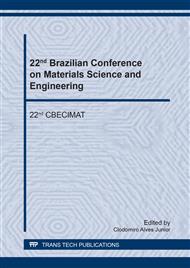p.311
p.317
p.322
p.327
p.333
p.339
p.345
p.349
p.356
Effect of Controlled Cooling after Hot Rolling on the Mechanical Properties of a Low Carbon Niobium Microalloyed Steel Wire Rod
Abstract:
The wire rod has high relevance due to its wide application as a raw material for steel wire and wire processed in cold rolling mills and drawing. The control of process variables, such as cooling rate, coiling temperature, rolling speed is essential for obtaining the microstructures and therefore mechanical properties of the material. The purpose of this work is to study the behavior of the microstructure and mechanical properties with the variation of thermomechanical treatment in the hot rolling of wire rod. The steels used in this study were the microalloyed niobium steel equivalent to ASTM A913 grade 50 and carbon steel equivalent to ASTM A510 grade 1013. Despite the carbon steel has higher equivalent carbon to microalloyed steel, was found higher yield strength (σe) in the microalloyed niobium steel. Thus, by applying appropriate thermomechanical treatment in microalloyed steel is possible to improve mechanical properties mainly due to grain refining.
Info:
Periodical:
Pages:
333-338
Citation:
Online since:
September 2018
Keywords:
Price:
Сopyright:
© 2018 Trans Tech Publications Ltd. All Rights Reserved
Share:
Citation:


